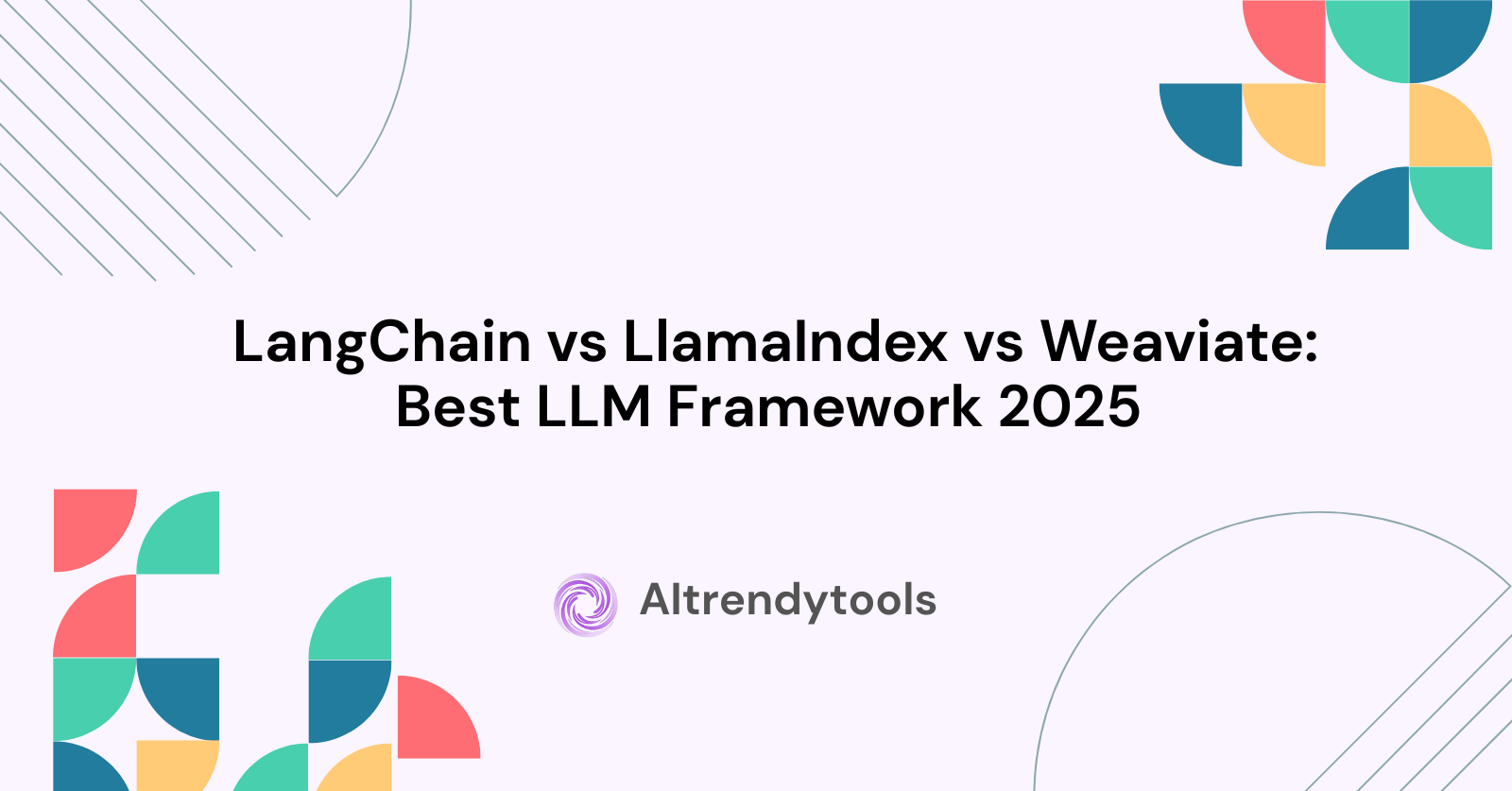🔥 AITrendytools: The Fastest-Growing AI Platform |
Write for usLangChain vs LlamaIndex vs Weaviate: Best LLM Framework 2025
Compare LangChain, LlamaIndex, and Weaviate for building AI apps. Discover which LLM framework suits your RAG system, vector database needs, and enterprise use cases.
Nov 19, 2025
LangChain vs LlamaIndex vs Weaviate: Which LLM Tooling System to Use?
Selecting the right framework for your AI project can make or break your development timeline. Developers face countless options when building applications powered by large language models. Three names consistently dominate discussions about LLM tooling: LangChain, LlamaIndex, and Weaviate.
Each tool serves distinct purposes in the AI development ecosystem. Understanding their differences helps teams avoid costly mistakes and accelerate time to market.
Understanding LLM Orchestration Frameworks
AI orchestration frameworks manage the complex interactions between language models, data sources, and application logic. These tools abstract away technical complexity.
Modern AI applications require more than just access to a language model. Developers need robust systems for data retrieval, context management, and workflow automation.
What makes a framework valuable:
- Simplified integration with multiple AI models
- Efficient data indexing and retrieval capabilities
- Flexible architecture for custom workflows
- Production-ready deployment options
- Strong community support and documentation
The right framework reduces development time from months to weeks. Poor framework selection leads to technical debt and scalability issues.
What is LangChain?
LangChain emerged as a comprehensive framework for building LLM-powered applications. Its modular architecture supports everything from simple chatbots to complex multi-agent systems.
Core Features of LangChain
The framework provides standardized interfaces for interacting with different language models. Developers can switch between OpenAI, Anthropic, or open-source models without rewriting code.
Key capabilities include:
- Prompt template management for consistent outputs
- Chain creation for multi-step reasoning workflows
- Agent systems with tool-calling capabilities
- Memory management for conversational context
- Integration with 100+ external tools and APIs
LangChain excels at orchestrating complex workflows. The framework handles everything from simple question-answering to sophisticated decision-making systems.
LangChain Use Cases
Companies use LangChain for customer service automation. The framework powers chatbots that access multiple data sources and make API calls.
Content generation platforms rely on LangChain's chain mechanisms. These systems process documents, extract information, and generate summaries automatically.
Enterprise teams build internal knowledge assistants with LangChain. Employees query company data through natural language interfaces.
When to Choose LangChain for AI Development
Your project needs LangChain when building conversational AI systems. The framework's agent capabilities handle dynamic user interactions effectively.
Multi-step reasoning tasks benefit from LangChain's chain architecture. Complex workflows requiring multiple LLM calls and tool integrations work smoothly.
Teams prioritizing flexibility should consider LangChain. The modular design allows extensive customization for unique requirements.
Best for:
- Chatbot development with tool integration
- Workflow automation systems
- Multi-agent orchestration
- API-heavy applications
- Projects requiring extensive customization
The learning curve is steeper than simpler alternatives. However, the investment pays off for complex enterprise applications.
What is LlamaIndex?
LlamaIndex specializes in connecting language models with custom data sources. The framework focuses specifically on data indexing and retrieval tasks.
Core Features of LlamaIndex
Data ingestion capabilities handle diverse formats including PDFs, databases, and APIs. LlamaIndex transforms unstructured information into searchable indexes.
Primary features:
- Advanced document parsing and chunking
- Multiple index types (vector, keyword, graph)
- Semantic search with embedding models
- Query engines for information retrieval
- Support for 160+ data connectors
The framework optimizes for Retrieval-Augmented Generation systems. RAG applications pull relevant context from knowledge bases before generating responses.
LlamaIndex Use Cases
Legal firms use LlamaIndex to search thousands of case documents. The system retrieves relevant precedents in seconds instead of hours.
Healthcare organizations index medical research papers. Doctors query the system for treatment information and clinical guidelines.
Enterprise knowledge management systems rely on LlamaIndex. Employees find answers from company documentation, wikis, and internal databases.
When LlamaIndex is the Right Choice
Your application centers on document search and retrieval. LlamaIndex provides purpose-built tools for these scenarios.
Projects with large proprietary datasets benefit from LlamaIndex's indexing capabilities. The framework handles millions of documents efficiently.
Teams building RAG systems should evaluate LlamaIndex first. Its specialized focus delivers better performance than general-purpose frameworks.
Ideal for:
- Document question-answering systems
- Enterprise search applications
- Research and analysis tools
- Knowledge base integration
- Context-augmented AI assistants
LlamaIndex requires less setup than broader frameworks. Teams can implement working prototypes in days.
What is Weaviate?
Weaviate differs fundamentally from LangChain and LlamaIndex. It's a vector database rather than an orchestration framework.
Core Features of Weaviate
Vector databases store and retrieve high-dimensional embeddings. Weaviate specializes in semantic search across large datasets.
Key capabilities include:
- Efficient vector similarity search
- Hybrid search combining vector and keyword methods
- GraphQL query interface
- Built-in vectorization modules
- Horizontal scaling for production workloads
The database integrates embedding models from OpenAI, Cohere, and Hugging Face. Developers can plug in different vectorizers without changing application code.
Weaviate Use Cases
E-commerce platforms use Weaviate for product recommendations. The system finds similar items based on descriptions and images.
Content platforms implement semantic search with Weaviate. Users discover related articles even without exact keyword matches.
AI applications store conversational context in Weaviate. The database quickly retrieves relevant past interactions.
When to Select Weaviate
Your application requires high-performance vector search. Weaviate handles billions of vectors with millisecond query latency.
Teams building production RAG systems need reliable vector storage. Weaviate provides enterprise-grade infrastructure.
Projects combining structured and unstructured data benefit from Weaviate's hybrid search. The database handles complex filtering alongside semantic similarity.
Best suited for:
- Large-scale semantic search
- Production RAG deployments
- Multi-modal search applications
- Real-time recommendation systems
- Enterprise data infrastructure
Weaviate requires infrastructure management expertise. The database needs proper configuration for optimal performance.
Comparing RAG System Implementation
Building Retrieval-Augmented Generation systems requires different components. Each tool plays a specific role in the RAG pipeline.
Data Ingestion and Processing
LlamaIndex provides the most comprehensive data connectors. The framework handles document parsing, chunking, and metadata extraction automatically.
LangChain offers basic document loading utilities. Developers typically combine LangChain with LlamaIndex for data preparation.
Weaviate focuses on storing processed data. The database expects pre-chunked documents with embeddings already generated.
Vector Storage and Retrieval
Weaviate excels at vector operations. The database delivers sub-50ms query times even with billions of vectors.
LlamaIndex supports multiple vector stores including Weaviate, Pinecone, and FAISS. It abstracts the underlying database implementation.
LangChain integrates with various vector databases. The framework provides a unified interface but doesn't optimize specifically for retrieval.
Performance considerations:
- Weaviate: Optimized for production scale
- LlamaIndex: Excellent for prototyping
- LangChain: Flexible but requires optimization
Teams often combine these tools for optimal results.
Context Enhancement and Generation
LangChain handles the generation phase effectively. The framework manages prompts, model interactions, and response formatting.
LlamaIndex focuses on retrieval quality. It ensures the most relevant context reaches the language model.
Weaviate provides the raw data. The database doesn't handle LLM interactions directly.
Integration Capabilities and Ecosystem
Modern AI applications require connections to multiple services. Framework integration options determine development efficiency.
LLM Provider Support
LangChain supports every major language model provider. The framework abstracts differences between OpenAI, Anthropic, Cohere, and dozens of open-source models.
LlamaIndex integrates seamlessly with popular LLMs. The focus remains on enhancing retrieval rather than model variety.
Weaviate connects with embedding services. The database doesn't interact directly with language models for generation.
Tool and API Integrations
LangChain offers 100+ pre-built integrations. These include search engines, databases, productivity tools, and custom APIs.
LlamaIndex provides 160+ data connectors. The emphasis is on ingesting information from diverse sources.
Weaviate integrates with other frameworks. Teams typically use it alongside LangChain or LlamaIndex.
Vector Database Compatibility
LlamaIndex supports all major vector databases. Developers can switch between Weaviate, Pinecone, FAISS, and others easily.
LangChain provides basic vector store interfaces. The implementations vary in optimization and features.
Weaviate is itself a vector database. It competes with alternatives like Pinecone and Qdrant.
Performance and Scalability Considerations
Production deployments demand reliable performance at scale. Each tool handles growth differently.
Query Latency
Weaviate delivers consistent sub-100ms queries for properly configured systems. The database scales horizontally for increased load.
LlamaIndex adds overhead during retrieval. Query times depend on the underlying vector database and retrieval strategy.
LangChain introduces additional latency through chains and agents. Complex workflows with multiple LLM calls take seconds to complete.
Handling Large Datasets
Weaviate manages billions of vectors effectively. Proper shard configuration ensures performance doesn't degrade.
LlamaIndex optimizes for document collections up to millions of items. Larger datasets may require careful index design.
LangChain doesn't directly manage data storage. Performance depends entirely on integrated vector databases.
Cost Efficiency
Open-source Weaviate reduces infrastructure costs. Self-hosted deployments avoid managed service fees.
LlamaIndex minimizes unnecessary LLM calls. Efficient retrieval reduces generation costs significantly.
LangChain's flexibility allows cost optimization. Developers can implement caching and routing strategies.
Enterprise AI Application Development
Corporate environments have unique requirements. Framework selection impacts security, compliance, and operational overhead.
Security and Data Privacy
Self-hosted Weaviate provides complete data control. Sensitive information never leaves company infrastructure.
LlamaIndex can process private documents on-premises. The framework doesn't require cloud services.
LangChain supports various deployment models. Teams choose between cloud APIs and local models based on requirements.
Deployment Options
Weaviate offers managed cloud services and self-hosted installations. Docker containers simplify deployment.
LlamaIndex runs anywhere Python is supported. The framework has minimal infrastructure requirements.
LangChain applications deploy to standard cloud platforms. The framework works with serverless architectures.
Maintenance and Operations
Weaviate requires database administration expertise. Teams must handle backups, monitoring, and upgrades.
LlamaIndex has minimal operational overhead. The framework updates through standard package management.
LangChain applications need ongoing maintenance. Complex chains require monitoring and optimization.
Building Production RAG Systems
Real-world implementations combine multiple tools. Understanding integration patterns prevents common pitfalls.
Recommended Architecture Patterns
Most production systems use LlamaIndex for data ingestion and indexing. The framework prepares documents efficiently.
Weaviate stores the indexed vectors for fast retrieval. The database handles production query loads reliably.
LangChain orchestrates the complete workflow. The framework manages user interactions and response generation.
Typical stack:
- LlamaIndex: Data preparation
- Weaviate: Vector storage
- LangChain: Application logic
- Cloud infrastructure: Deployment
This combination leverages each tool's strengths.
Common Implementation Challenges
Teams often underestimate chunking strategy importance. Poor document splitting degrades retrieval quality significantly.
Vector database configuration requires expertise. Default settings rarely deliver optimal performance.
Prompt engineering remains critical. Even perfect retrieval fails with poorly designed prompts.
Best Practices for Success
Start with simple implementations before adding complexity. Prove core functionality works reliably.
Measure retrieval quality separately from generation quality. This separation simplifies debugging.
Implement comprehensive monitoring from day one. Understanding system behavior prevents production issues.
Framework Learning Curves and Developer Experience
Team productivity depends on framework accessibility. Some tools require more expertise than others.
Documentation Quality
LangChain maintains extensive documentation with numerous examples. The community contributes tutorials regularly.
LlamaIndex provides clear getting-started guides. Documentation sometimes lags behind new features.
Weaviate offers comprehensive database documentation. GraphQL query examples help developers quickly.
Community Support
LangChain has the largest community. Developers find answers to most questions through GitHub discussions.
LlamaIndex community grows rapidly. Integration examples for common use cases exist.
Weaviate maintains active community forums. The team responds quickly to technical questions.
Time to First Working Prototype
LlamaIndex delivers fastest time to prototype. Basic RAG systems work in under 100 lines of code.
LangChain requires understanding chains and agents. Initial learning takes several days.
Weaviate needs infrastructure setup first. Cloud deployments simplify this process.
Making Your Framework Decision
No single framework suits every project. Specific requirements should guide selection.
Choose LangChain When
Your application requires complex multi-step workflows. Agent systems with tool-calling benefit from LangChain's architecture.
Conversational AI projects need sophisticated state management. LangChain's memory systems handle this effectively.
Teams want maximum flexibility for unique requirements. The modular design supports extensive customization.
Choose LlamaIndex When
Document search and retrieval form your core functionality. LlamaIndex optimizes specifically for these tasks.
Projects center on RAG system implementation. The framework provides purpose-built tools.
Rapid prototyping matters more than extensive features. LlamaIndex delivers working systems quickly.
Choose Weaviate When
Production vector search requires enterprise performance. Weaviate scales to billions of vectors reliably.
Data infrastructure needs are critical. The database provides robust storage for AI applications.
Hybrid search combining vectors and keywords is necessary. Weaviate handles both efficiently.
Combining Tools for Optimal Results
The best solutions often integrate multiple frameworks. Each tool contributes specific capabilities.
LlamaIndex excels at data preparation and indexing. Use it to transform raw documents into searchable knowledge bases.
Weaviate provides production-grade vector storage. The database handles scale and performance requirements.
LangChain orchestrates the complete application. It manages user interactions and complex workflows.
This integrated approach delivers better results than any single tool alone. Each component focuses on its strengths.
Future Trends in LLM Tooling
The AI development landscape evolves rapidly. Understanding trends helps future-proof technology decisions.
Framework consolidation continues as tools mature. Clearer specialization emerges between orchestration and infrastructure.
Multi-agent systems gain prominence. Frameworks increasingly support agent-to-agent communication.
Evaluation and monitoring become standard features. Production AI demands robust observability tools.
Open-source alternatives to proprietary models accelerate. Frameworks adapt to support local deployment.
Conclusion
LangChain, LlamaIndex, and Weaviate serve complementary roles in AI development. Understanding their differences enables better architectural decisions.
LangChain provides comprehensive orchestration for complex workflows. Its flexibility suits enterprise applications with unique requirements.
LlamaIndex specializes in data retrieval and RAG systems. The framework delivers rapid development for document-centric applications.
Weaviate offers production-grade vector database infrastructure. Teams building at scale need its performance characteristics.
Most production systems benefit from combining these tools. Use each framework for its specific strengths rather than forcing a single solution.
Your project requirements should drive framework selection. Evaluate based on core functionality, team expertise, and growth plans.
Start with simple implementations before adding complexity. Prove value quickly, then enhance based on real usage patterns.
The right tooling accelerates AI development dramatically. Choose wisely based on your specific needs rather than following trends.
🚀 Submit Your Tool to Our Comprehensive AI Tools Directory
Get your AI tool featured on our complete directory at AITrendytools and reach thousands of potential users. Select the plan that best fits your needs.





Join 30,000+ Co-Founders
Related Blogs
Dext Review 2025: Guide to Automate Your Bookkeeping
Discover how Dext software transforms expense management with 99.9% accuracy. Complete guide to features, pricing, integrations & alternatives for 2025.
Texto Invisible: 10 Ways to Copy Hidden Text & Blank Space
Master texto invisible for WhatsApp, Instagram & gaming. Learn how to create hidden text, blank characters & empty spaces. Free generator + step by step guide
WriteHuman AI Review: Does It Really Bypass AI Detectors?
Honest WriteHuman AI review with real testing results. Learn if this AI humanizer actually works, pricing details, and better alternatives for 2025.
Submit Your Tool to Our Comprehensive AI Tools Directory
List your AI tool on AItrendytools and reach a growing audience of AI users and founders. Boost visibility and showcase your innovation in a curated directory of 30,000+ AI apps.





Join 30,000+ Co-Founders

